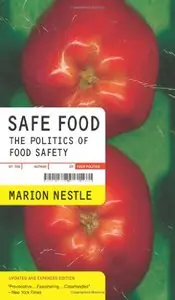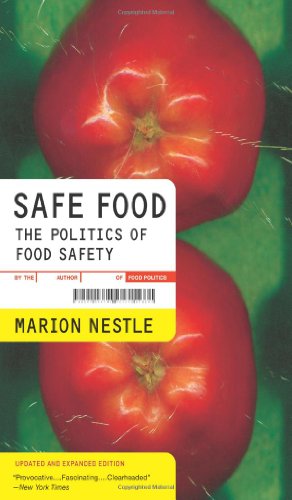Safe Food: The Politics of Food Safety By Marion Nestle
Publisher: Uni.ver.sity of Cali.for.nia Pre.ss, Updated and Expanded 2010 | 408 Pages | ISBN: 0520266064 | EPUB + PDF | 4 MB + 4 MB
Publisher: Uni.ver.sity of Cali.for.nia Pre.ss, Updated and Expanded 2010 | 408 Pages | ISBN: 0520266064 | EPUB + PDF | 4 MB + 4 MB
"Food safety is political." So claims the title of the introduction to Marion Nestle's book Safe Food, and this assertion is solidly confirmed in the pages that follow. In her instructive monograph, Nestle exposes the political workings of the system that supposedly guarantees the safety of our food. The operation of this system is unfamiliar to many, but Nestle's well-researched and carefully documented arguments convince me that the topic should be of concern to anyone who eats. Most Americans believe that the United States has the safest food supply in the world. But is this belief justified? Does the public know what the government does and does not do regarding food inspection? How many people believe that their ground sirloin is tested for Escherichia coli O157:H7, their chicken for campylobacter, and their cold cuts for listeria? How many know whether their taco shells are made from transgenic corn? Do people assume that the package label reflects this information? And most important, do they know who decides what is done to ensure food safety and why? The answers to these questions are surprisingly predictable when one considers the workings of other regulatory systems in our society. In Safe Food, we learn of food producers that place the interests of stockholders above those of the public, byzantine government agencies that work at cross-purposes, the flow of personnel between government and industry that confuses the goals of the watchdog with those of the watched, and a spectrum of citizens' groups that engage in activities ranging from responsible public advocacy to street theatrics and "biovandalism." In essence, all the troubling problems of the military-industrial complex seem also to be manifested in our food-production system. Safe Food addresses all these elements in two major sections and a conclusion that roughly correspond with the three Bs in the book's subtitle. Part one, "Resisting Food Safety," includes an account of the government agencies concerned with food safety -- there are no fewer than 12 -- and their sometimes inexplicable regulatory responsibilities. For example, the reader learns that the U.S. Department of Agriculture (USDA) oversees the production of hot dogs in pastry dough, whereas the Food and Drug Administration (FDA) regulates hot dogs in rolls. Beef broth and dehydrated chicken soup are regulated by the USDA, but chicken broth and dehydrated beef soup are regulated by the FDA. After this look at the regulatory side of the process, Nestle turns to a discussion of food producers' historical resistance to regulation. Since 1906, one role of USDA meat inspectors has been to exclude diseased animals from the food supply. The suggestion to refocus oversight on specific pathogens by instituting Hazard Analysis and Critical Control Point (HACCP) systems at critical points in food production has been repeatedly deferred by political and legal actions since the early 1980s. For example, from 1971 until the mid-1990s, the meat industry argued successfully that foodborne pathogens such as E. coli O157:H7 are inherent components of raw meat and therefore not "adulterants" that are subject to regulation. Part two of the book recounts the efforts of biotechnology firms to introduce genetically modified foods onto the farm and into the food supply. This introduction was accomplished with the complicity of government agencies but largely without the knowledge or consent of the public. Industry aggressively promotes genetically engineered foods as the solution to world hunger. But what evidence supports this claim? And what of the hidden dangers of so-called Frankenfoods to our health and economy that some outspoken critics predict? Nestle stresses two major themes here: the exploitation of science-based justifications for points of view on either side of the question, and the notion that public opinion in these matters is often based on values, a sense of dread, and a healthy distrust of institutions, rather than on scientific principles. The conclusion, which deals with bioterrorism, may be the weakest part of the book. Here the author uses examples of novel foodborne diseases, such as mad cow disease, to show how authorities might react to a deliberate contamination of the food supply. A few minor inaccuracies in the argument are more annoying than substantive, but the premise itself is a bit of a stretch. The last major revolution in food safety in this country followed the publication of Upton Sinclair's 1906 fictional expose, The Jungle. Remarkably, our system for securing the food supply has grown in size and complexity but only marginally in scope since then. Safe Food will probably not generate the public uproar that Sinclair's book did, but it expresses in scholarly terms the compelling reasons for undertaking another reorganization of the system. An advocate holding a passionate and transparent point of view, Nestle concludes her book with a list of specific suggestions for the food industry, the federal government, and the public. As citizens, consumers, and patient advocates, physicians would be wise to be informed about these issues and their possible solutions.
Be Happy!!!
!!!No Mirrors below, please! Follow Rules!



